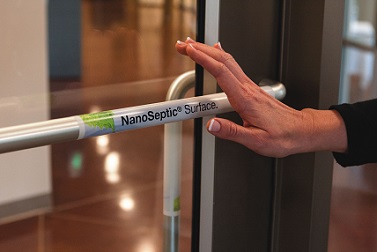 FOREST, VA.—NanoTouch Materials announced broad support for corporate ESG (environmental, social and governance) initiatives as well as UN SDGs (United Nations sustainable development goals) with their line of self-cleaning surfaces for facilities.
FOREST, VA.—NanoTouch Materials announced broad support for corporate ESG (environmental, social and governance) initiatives as well as UN SDGs (United Nations sustainable development goals) with their line of self-cleaning surfaces for facilities.
One of the main categories of initiatives has to do with health and wellness in the built environment. Commercial real estate owners and investors, along with facility managers and facility services firms, are racing to offer innovative new approaches in this category.
“We’re very excited to be able to contribute to these wellness initiatives with products that also positively impact occupant experience,” says NanoTouch Co-founder Dennis Hackemeyer. “Imagine having an autonomous cleaning team that begins cleaning door handles and elevator buttons immediately after every touch. That’s the essence of what NanoSeptic touch points do in a facility.”
The world’s largest real estate services firms such as CBRE, JLL and Cushman & Wakefield are applying the UN SDGs to the built environment and rolling them into their own ESG initiatives.
NanoSeptic self-cleaning surfaces not only contribute to health and wellness strategies, but also help on the sustainability front since they provide cleaner touch points without chemicals, using technology rather than toxins.
Improved Occupant Experience
The visible nature of these touchpoints contributes to stakeholder engagement by improving client satisfaction through improved occupant experience. Now tenants know where the cleaner places to touch are because they can see them, providing a sense of safety and security and a visible component to employee wellness programs. The rapid growth of outsourced commercial real estate services has led to a search for this type of PropTech that can improve employee health and wellness, leading to greater occupant satisfaction.
“Partially funded by a $2 million R&D grant, NanoTouch has conducted extensive research into the psychology of people in facilities and their perception of cleanliness,” says co-founder Mark Sisson. “We found that in many cases, facilities benefited from how the self-cleaning surfaces made people feel rather than what they did. It created a ‘halo effect’, which is when people make broad assumptions from limited information. In this case, occupants and guests assumed the rest of the facility was much cleaner when they saw self-cleaning surfaces.”
Cushman & Wakefield’s corporate responsibility report highlights how presenteeism, where employees come to work even though they are sick, costs businesses $1.5 trillion per year, which is 10 times the cost of absenteeism. For every dollar spent on wellness, an organization can expect to receive up to $10 back in value.
“We applaud the efforts outlined in the Well Building Standard,” says Hackemeyer. “While most of the initiatives center around mental health, fitness and nutrition, we believe a cleaner building is a healthier building. Autonomous self-cleaning surfaces can play a pivotal role in creating facilities that are cleaner, not just immediately after routine cleanings, but around the clock.”
Green, Non-Toxic Self-Cleaning Surfaces
Mitigating environmental impact of commercial facilities is another major issue, part of which is reducing the chemical footprint related to cleaning operations. Green, non-toxic self-cleaning surfaces can be part of a facility’s environmentally sustainable best practices.
In addition to ESG initiatives, major players in the industry are taking part in impact investing, which refers to an investment strategy that not only generates financial return, but also creates a positive social and environmental impact. This includes equity investments in companies that are mindful of ESG factors, combining purpose and profit. Impact investing is similar to Socially Responsible Investing (SRI). But while SRI generally focuses on avoiding harm, impact investing actively seeks to create positive outcomes. Examples of this include JLL with their Spark global venture capital fund and CBRE with their funding of the Fifth Wall venture capital fund.
NanoTouch Materials will be seeking $5 million in funding with their first-round equity offering in the fourth quarter of 2019 and will be evaluating Impact Investing firms and venture capital firms that specialize in technology for the built environment as potential investors.






